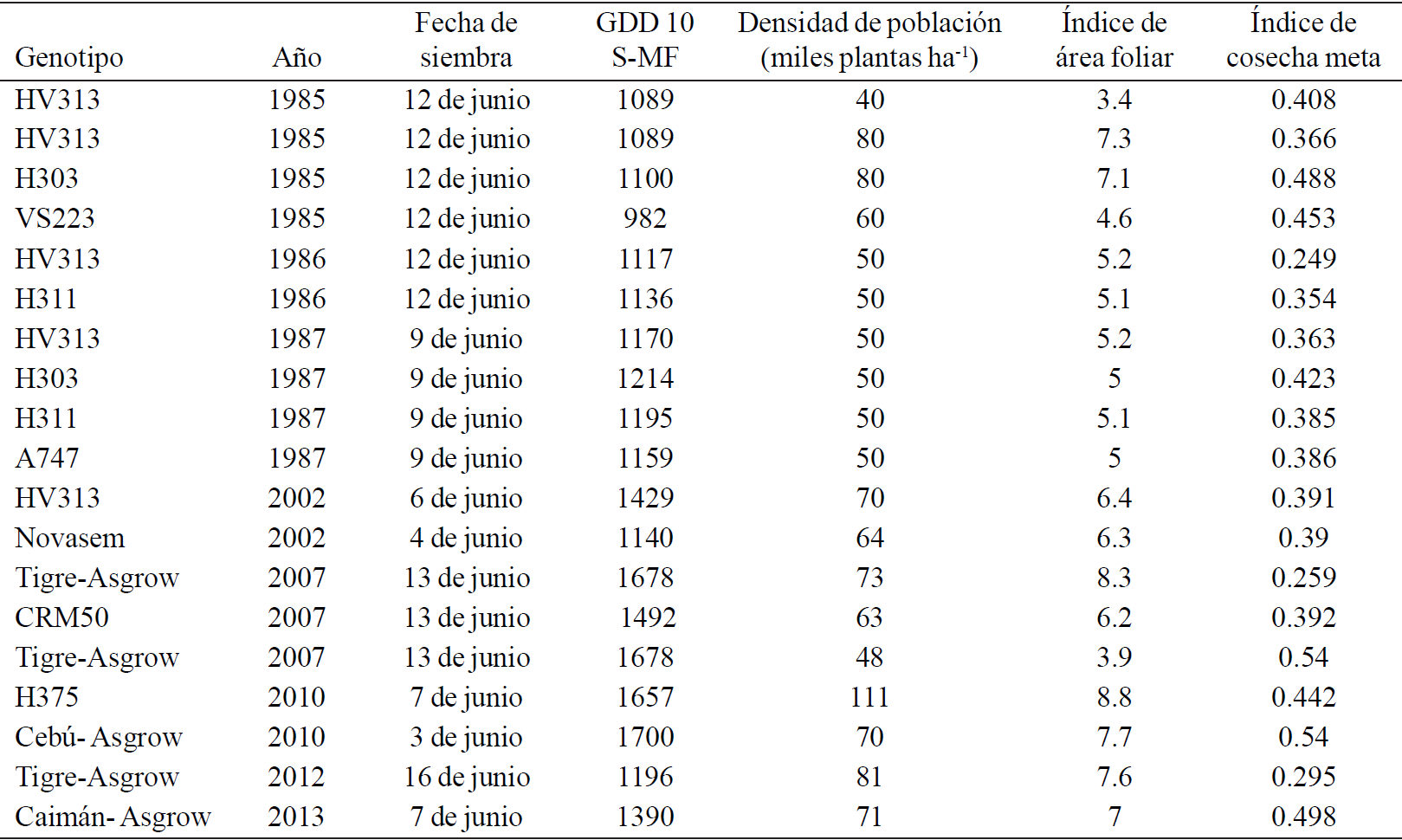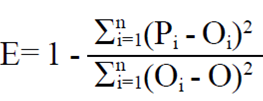Servicios Personalizados
Revista
Articulo
Indicadores
-
 Citado por SciELO
Citado por SciELO -
 Accesos
Accesos
Links relacionados
-
 Similares en
SciELO
Similares en
SciELO
Compartir
Revista mexicana de ciencias agrícolas
versión impresa ISSN 2007-0934
Rev. Mex. Cienc. Agríc vol.5 no.spe10 Texcoco nov./dic. 2014
Articles
Applying the model EPIC to assess the impact of climate change and management practices on grain yield in rainfed maize
1Campo Experimental Centro Altos de Jalisco-INIFAP. Carretera Tepatitlán de Morelos-Lagos de Moreno, km 8, Tepatitlán de Morelos, Jalisco. C. P. 47600. Tel. (378) 7820355 ext. 142. (ruiz.ariel@inifap.gob.mx; delamora.celia@inifap.gob.mx; chavez.alvaro@inifap.gob.mx).
2Departamento ProducciónAgrícola. Centro Universitario de Ciencias Biológicas y Agropecuarias. Universidad de Guadalajara. Carretera Guadalajara-Nogales, km 15.5. (paty.zarazua@hotmail.com; hramirez@cualtos.udg.mx).
3CENID-RASPA-INIFAP. Margen derecha Canal Sacramento, km 6.5. C. P. 35140. Gómez Palacio, Durango. México. Tel. (871) 7191076. (velasquez.agustin@inifap. gob.mx).
The model EPIC was calibrated and validated for studying the effect of management practices and climate change on the grain yield of rainfed maize for Altos-Sur and Cienega regions of Jalisco. The climate change scenario was used with the pattern of representative concentration (PCR) of 2.6 W/m2, proposed by the IPCC (2013). The calibration and validation of EPIC used the experimental data with maize rainfed cropping systems obtained in the Experimental CenterAltos de Jalisco (CECEAJAL) ofINIFAP from 1985 to 2013. The information came from the weather station La Barca ofthe CNAand the agroclimatic station CECEAJAL. The soil data were obtained from profiles INIFAP although for each year and location the results of soil analysis in the Ap layer was used. Climate generator EPIC was used with the values of the basic statistics required of the above stations. Grain yield was simulated every five years up to a period of100 years, managing nine cropping systems, three for the Altos-Sur region and six for the region, Cienega. Of the latter, two tillage systems and four conventional soil incorporation of crop residues were included, with a high content oforganic matter. The results showed that, the grain yield management practice in the Altos-Sur of Jalisco with low planting density region collapses after 2075, while in the high density the yield begins to decline at a later time. For the region Cienega the maize crop residue incorporation has a more stable yield, but after 2075 tends to fade as well.
Keywords: climate change; maize; management practices
Se calibró y validó el modelo EPIC, para estudiar el efecto de prácticas de manejo y cambio climático sobre el rendimiento de grano de maíz de temporal para las regiones Altos-Sur y Ciénega de Jalisco. Se utilizó el escenario de cambio climático con el patrón de concentración representativa (PCR) de 2.6 W/m2, propuesto por el IPCC (2013). La calibración y validación de EPIC utilizó la información experimental con sistemas de cultivo de maíz de temporal obtenidos en el Campo Experimental Centro Altos de Jalisco (CECEAJAL) de INIFAP de 1985 a 2013. La información de clima procedió de la estación climática del La Barca de la CNA y la estación agroclimática de CECEAJAL. Los datos de suelo se obtuvieron de los perfiles de INIFAP, aunque para cada año y localidad se utilizó los resultados del análisis de suelos de la capa Ap. Se utilizó el generador climático del EPIC con los valores de las estadísticas básicas requeridas de las estaciones antes mencionadas. Se simulo el rendimiento de grano cada cinco años hasta alcanzar un periodo de 100 años, con el manejo de nueve sistemas de cultivo, tres para la región altos sur y seis para la región Ciénega. De esta última se incluyeron dos sistemas de labranza del suelo convencional y cuatro la incorporación de residuos de cosecha, con un alto contenido de materia orgánica. Los resultados mostraron que el rendimiento de grano con la práctica de manejo en la región Altos Sur de Jalisco de baja densidad de siembra colapsa después de 2075, mientras que el maíz con mayor densidad de siembra el rendimiento comienza a decaer en tiempo posterior. Para la región Ciénega el maíz con incorporación de residuos de cosecha tiene un rendimiento más estable, pero después de 2075 tiende a decaer el rendimiento.
Palabras clave: cambio climático; maíz; prácticas de manejo
Introduction
Rainfed maize is the most important crop in Mexico with an area of increased plantings of 56% of the agricultural area, and average 2.26 t ha-1. Jalisco is the State with the largest area planted 565,486 ha and an average yield of 5.37 t ha-1 (SIAP, 2012); in this State the region Cienega stands with an area of close to 25% seed and grain yield by 7.33 t ha-1. Another important area is the Altos de Jalisco, particularly the close relationship that has maize to livestock production, particularly family dairy (Flores et al, 2007). Productivity in rainfed maize in the region Cienega, Jalisco, characterized by a system ofmonocroping with high use ofinputs, particularly fertilizer, improved seeds and pesticides to control pests and weeds, with two variants important in the management of waste, one is the extraction of these at about 90% and another is the inclusion of 100% ofwaste (Flores et al, 2011); instead the Altos de Jalisco also has high availability of manure, typical input maize in this region (Flores et al, 2009).
The yield ofmaize in Jalisco during the last 10 years has shown a sustained increase in the order of 285 kg/ha/year (Flores et al, 2011), but the low efficiency ofmanagement practices by applying inputs in maize make it a high economic cost cult and important source of diffuse pollution caused deterioration of soil and surface water (Flores-López et al, 2012).
In this context, agriculture is an activity consisting of four site-scale components: climate, soil, and crop and farmer management technology on these three components. Of particular importance is the dependence of agriculture on climate, because of its high sensitivity to global climate change and climate variability, because is essential to understand the interactions between climate change and agricultural production for the stable development of society (Hui et al, 2013). However, this same activity with industry and urbanization, emit greenhouse gases contributing significantly to global warming and climate change, global temperature increase of 0.74 °C from 1906-2005 (IPCC, 2007).
This is the reason that a recurring theme is the effect of research aimed at understanding the effect of management practices on crop grain yield and its long term effect on the economy (Chavas et al, 2009) in the processes related to the dynamics ofsoil organic matter (Aurbacher et al, 2013), the soil water dynamics (Huszar et al, 1999), reduced crop cycle (Gohari et al, 2013), among others.
According to the IPCC (2013), the emissions of CO2 by human activities are considered the main cause of climate change, in 2011 the CO2 emissions were around 390 ppm with an average annual increase of the last 15 years in the order of1.35 ppm; according to the patterns ofrepresentative concentration (PCR) acting on the radiative forces (FR), four possible scenarios for future changes occur: PCR with FR of 2.6, 4.5, 6 and 8.5 W/m2. According to this scenario, the simulation models show that, the surface temperature on overall average will be about 0.3 to 1.7 °C for the PCR2.6, from 1.1 to 2.6 °C for the PCR4.5, 1.4 to 3.5 °C for PCR6.0 and 2.6 to 4.8 °C for PCR8.5. With regard to the water cycle, the IPCC (2013) reports a significant contrast between dry and wet rainfall regions, but also between the dry and wet seasons, except for some regions, but with increase in extreme rainfall events.
Climate change has an ambivalent impact on agriculture, so that while increasing mean temperatures and atmospheric CO2 content, the result is an increase in yields (Farina et al., 2011), but also smaller amount of precipitation during summer and increased precipitation variability and patterns of rainfall and evapotranspiration and larger amounts of vapour in the atmosphere with serious implications for the global hydrological cycle (Gohari et al., 2013;Aurbacher et al., 2013).
In Mexico, there is a tendency in some agricultural areas to increase the temperature perceptibly from 1990 to date is shown (Ruiz et al, 2011; Zarazúa et al., 2011) and a slight decrease in annual precipitation in producing areas (Ruiz et al, 2011). The consequence ofthese changes is expected to be reflected in increases in potential evapotranspiration, with a water balance less favourable, reducing the growing season in tropical and subtropical areas, but with equal or higher accumulation of heat units and growing season equal to or larger in the high valley (Hatfield et al, 2011), with a reduction in the ability of the land to produce maize, lower profitability, but in general, the reduction of the production potential of the crops will be associated with greater dynamism in the presence of pests, diseases and weeds (FAO, 2007).
In this context, the agricultural systems have a particular response with the management practices used on the site, so we need to identify their long-term impact and how to direct them to the mitigation/adaptation to climate change and the contribution they have to maintain for agricultural productivity (Lal et al, 2011). With this consideration the management of the agricultural system it is likely that the response of crops like maize in Jalisco, can be damped, which can lead to mitigation-adaptation of the great ecological, economic and social problems that are expected for this crop.
The inherent complexity of agricultural systems makes it difficult to make decisions on crop management, a problem exacerbated in recent years with climate change. One option for solving this problem is the use of simulation models to predict process-based cultivation results, which provide explanations of the dynamic behaviour of the system to changes in the environment, genotype and management, justifying its application in projecting the impacts ofclimate change and adaptation in agricultural production. One of these simulation models (MS) is the EPIC which originally was constructed to quantify the effects of erosion on soil productivity (Williams, 1990).
Today it has become a tool to describe high degree of certainty the yield of crops with complex rotations and tillage operations in more than 100 crops, with routines to evaluate the management of the effects of fertilization, the increase in CO2 and temperature in the atmosphere, with its implications on the use of rainwater or irrigation, plant growth, nutrient cycling N and P fertilizers or chemical form, the dynamics of crop residues, and density changes soil tillage, erosion and leaching (Kiniry et al., 1995; Hilger et al, 2000; Wang et al., 2006; Gaiser et al., 2010), which makes it a suitable model to evaluate the consequences of increased CO2 and temperature on the global climate of the earth, as predicted by the IPCC (2013).
Adaptation to specific locations, requires only computer and information acquisition a few cycles of crop growth to calibrate the model in the appropriate environment (Hodges, 1987), where the main obstacle to its use is the availability of information for calibration and validation (Angulo et al, 2013).
The MS operating parameters basically develop individual simulation processes studied experimentally in field or laboratory tests. The process of assessment and collection of such parameters is known as parameterization; these parameters are involved in multiple processes which cannot be studied independently in separate experiments; this process is known as model calibration (Witt, 1978). Within the parameters required to operate the model there are some that have more effect on their behaviour or yield; identification of these parameters is known as sensitivity analysis (Witt, 1978; Ferrer et al., 2000). In maize, the parameters that have been most sensitive model EPIC are the leaf area index, harvest index, crop cycle expressed by accumulated degree days from planting to maturity development (Kiniry et al., 1995).
Once the calibration and sensitivity analysis of MS have been done, it is necessary to resort to the validation process to identify and correct various aspects of the model that can distort and distract from the fact the predictions made, achieving adequate growth simulation, development or yield, defining an adjustment to what happens on the field. The aim ofthis study was to calibrate and validate the model EPIC on rainfed maize to assess the effect of climate change and management practices on grain yield ofrice in the region, Cienega and Altos Sur of Jalisco.
Materials and methods
Model calibration EPIC. Model calibration in rainfed maize used the experimental data of maize described in Table 1.
Model validation EPIC. Model validation used the experimental data of maize described in Table 2.
Climate and soil. Climate information from weather stations listed in Table 3 were used. The simulation of long-term maize yield climate model generator EPIC was used with the parameters obtained from the stations shown in the Table 3. Regarding the soil, the database with information from laboratory analyses of soil profiles in the study area generated by INEGI was used. For experimental site used the analysis of the surface horizon (Ap) was used.
Table 3 Weather stations used in the calibration and validation of EPIC and characteristics of climate and soil.

Assessing the effect of management practices for rainfed maize screened every five years, with the following considerations:
The change in the average temperature 0.01 °C/year, according to the pattern of concentration representative PCR2.6, conservative scenario in which we could expect a change in temperature from 07 to 1.06 °C (IPCC, 2013).
The rate of change in the concentration of CO2 was 1.4 ppm CO2/year, according to the pattern of concentration representative PCR2.6, also expecting a concentration of 480 ppm of CO2 at the end of 2100, with a range of 450-520 ppm CO2 (IPCC, 2013).
We did not included change on the amount ofprecipitation, only including this element on the water balance (IPCC 2013).
Yield evaluation model EPIC.
Statistical evaluation of model yield EPIC, used the following tests:
Mean square root of the error (MSRE):
Efficiency of the Nash-Sutcliffe model (E):
Index of agreement (d):
Average error (EP):
Coefficient of determination (r2):
Where: n is the number of samples, Pi and Oi are the predicted and observed values, and O is the mean ofthe observed data. With close to zero the root mean square error (MSRE), the more accurate is the model. The model efficiency (E) is between 0 and 1; an efficiency of 1 corresponds to a perfect match between the model estimates and observed data values; with E equal to zero indicates thatthe model predictions are as accurate as the mean ofthe observed data, while a lower efficiency than zero (-0 < E < 0) occurs when the observed mean is a better predictorthan the model. The index ofagreement (d) represents the ratio of the mean square error and potential error, so that a value of d equal to 1 represents a perfect match between the measurement and the model prediction. The coefficient of determination (r2) and the slope and intercept compares the predicted with the observed value. Test "t" was used for comparison between management practices.
Results and discussion
Calibration and validation of the model EPIC
The Table 4 shows the results ofstatistical tests for calibration and validation of the simulation model yield EPIC. The MSRE has over 1.25 t h-1 in the prediction for the calibration and validation ofthe model, particularly with the middle and high yields, a situation that affects the efficiency (E) of the model with values of0.7 and 0.68, respectively. With respect to the index of agreement (d), the simulations show high coherence values between simulated and measured yields.
In Figure 1a and b diagrams shown with maize yields estimated versus observed for model calibration and validation EPIC with its linear regression. The coefficient of determination (r2) has values of 0.82 and 0.78, respectively, and a slope higher than unity and lower intercept than zero, indicating a tendency to underestimate and overestimate high yields slightly lower yields.
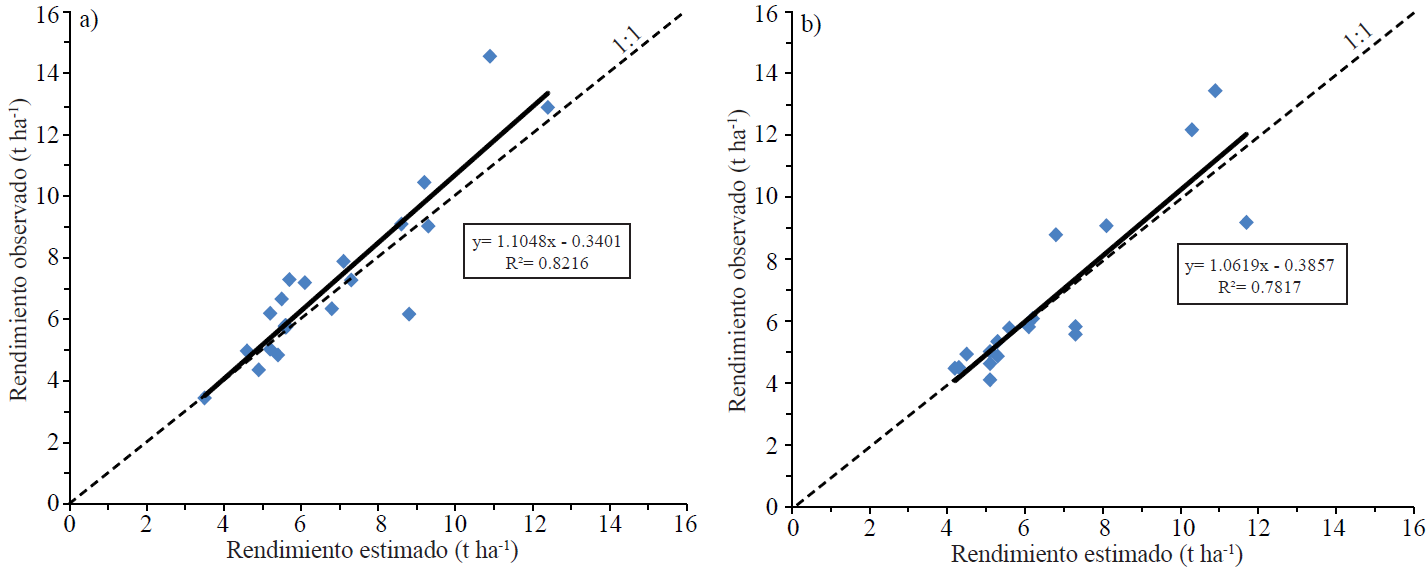
Figure 1 Relationship between grain yield observed for maize grain yield estimated: a) calibration; b) Model validation EPIC.
The results of the calibration and validation of the model EPIC obtained in this study are similar to those observed by Gaiser et al. (2010) , the calibration and validation of this model to simulate maize production in the humid tropics of West Africa and the semi-arid region of Brazil. However, these authors emphasize the importance of harvest index for genotypes oflandrace maize and improved yield and materials are influenced by the physicochemical characteristics of the soil. Given the results presented in model validation, EPIC calibration presents a good yield for use in simulating maize yields to assess the impact of proposed climate change.
Modelling the effect ofyield practices and climate change on maize yield
The EPIC calibrated and validated model, the PCR2.6 climate change scenario was used with the management practices shown in the Table 4, and assess the impact of climate change on maize production system in the rainfed regions Altos-Sur and Cienega of Jalisco. The Figure 2 shows the yield trend for the next 100 years shown with the estimated five years to practices evaluated in the region Altos-Sur of Jalisco handling yield. The average yield between PRC1 and PRC2 and PRC3 practices, was 7.7, 9.8 and 9.1 t ha-1, respectively, with significant differences between PRC2 and PRC1 against PRC3, but no significant differences between PRC2 and PRC3.
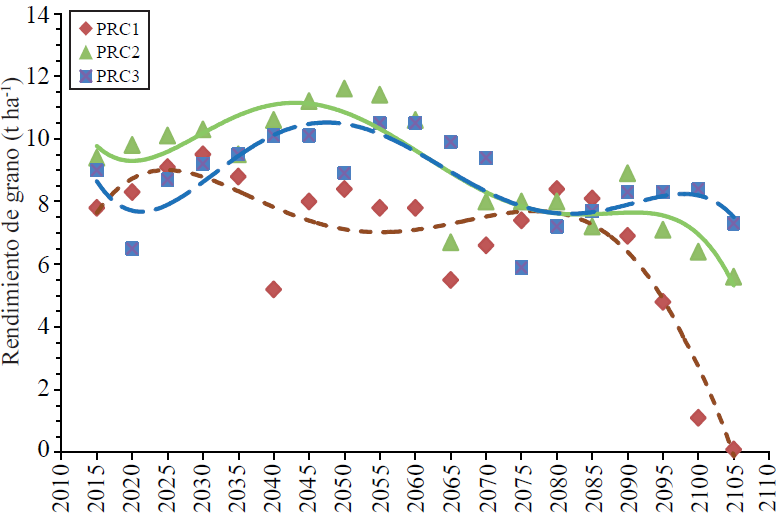
Figure 2 Trend of grain yield in rainfed maize estimated five years in the region Altos-Sur Jalisco, for the next 100 years.
It is remarkable the difference in yield management practices with PRC2 and PRC1 PRC3, particularly after 2080, where the maize falls steeply PRC1 management. At this point, the temperature is expected to reach at least 0.8 °C increase in temperature and 83 pm CO2 in the atmosphere, under the most conservative climate change scenario with 2.6 W/m1 radiative force (IPCC, 2013). The PRC1 scenario involved the use of an intermediate-early genotype under IAF and the use ofmanure and chemical fertilizer two, with the most critical result for maize yield.
Although, the interaction ofmanagement practices ofmaize is complex with climate change scenarios, the explanation of the collapse of handling PRC1 and PRC2 less impact in 2080 and 3 following scenarios could occur by the increase ofCO2 in the atmosphere, in that increased use of plant water are reported for the reduction ofevapotranspiration (Hatfield et al., 2011) but also the increase in temperature increases the length ofthe growing season, availability and mineralization of nitrogen and changes in the availability of moisture (Izaurralde et al., 2011; Ruiz et al., 2011), an increase in the soil temperature increases in the mineralization of the OM (Lin and Zhang, 2012).
For PRC1 practice it has low LAI (2.7), which favours evaporation with a consequent reduction in water availability for cultivation and ET reduced by increased CO2. The same situation is observed in PRC3 PRC2 and practices, but with less intensity. After 2080, the practice seems PRC3 cushion the impact of climate change, so it is necessary to further analyse the behaviour of this system of management of maize. Although the IAF is identified as a limiting factor in yield under climate change, it is necessary to examine other factors associated with the response of maize , such as planting date, crop cycle, soil erosion, dynamic soil organic matter could dampen these effects.
Grain yield obtained for handling scenarios region Cienega shown in Figure 3. The average yields for practical PRC4, 6, 7, 8, 9 and 10 were 7.1, 6.4, 6.1, 6.6, 6.5 and 6.1 t ha-1, respectively, with no significant differences between scenarios. The trend in the yield of this figure shows that after 2075 the yield begins to decline, for the same reasons that occur in the yield of the region Altos-Sur.
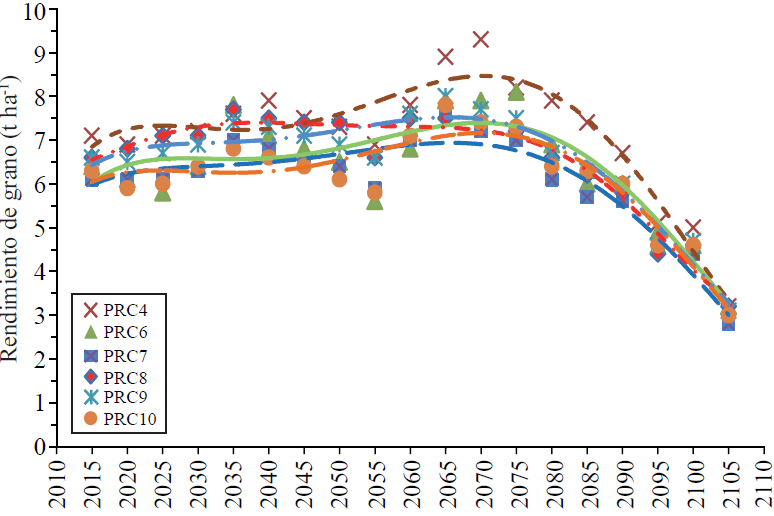
Figure 3 Trend of grain yield in maize under temporary management practices in six periods of five years for the region, Cienega of Jalisco in Mexico.
Although the yields from tríese practices were no statistically significant differences, we had two groups of practices with a significant contrast: the management of crop residues. In scenarios PRC4 and PRC6 not harvest residues are left, but in the PRC7, 8, 9 and 10 scenarios, crop residues incorporated into the soil with two steps of drag, which results in that the content of organic matter (OM) of soil is taken at levels up to 4.6%. In Figure 4a and b trend maize yield for the region Ciénega is shown with management practices grouped tillage with crop residue incorporation without residue incorporation. In this figure the trend of management practices with residue incorporation remains the most stable practices without residue incorporation, profit attributable to the increase in soil organic matter yield (Causarano et al., 2008).
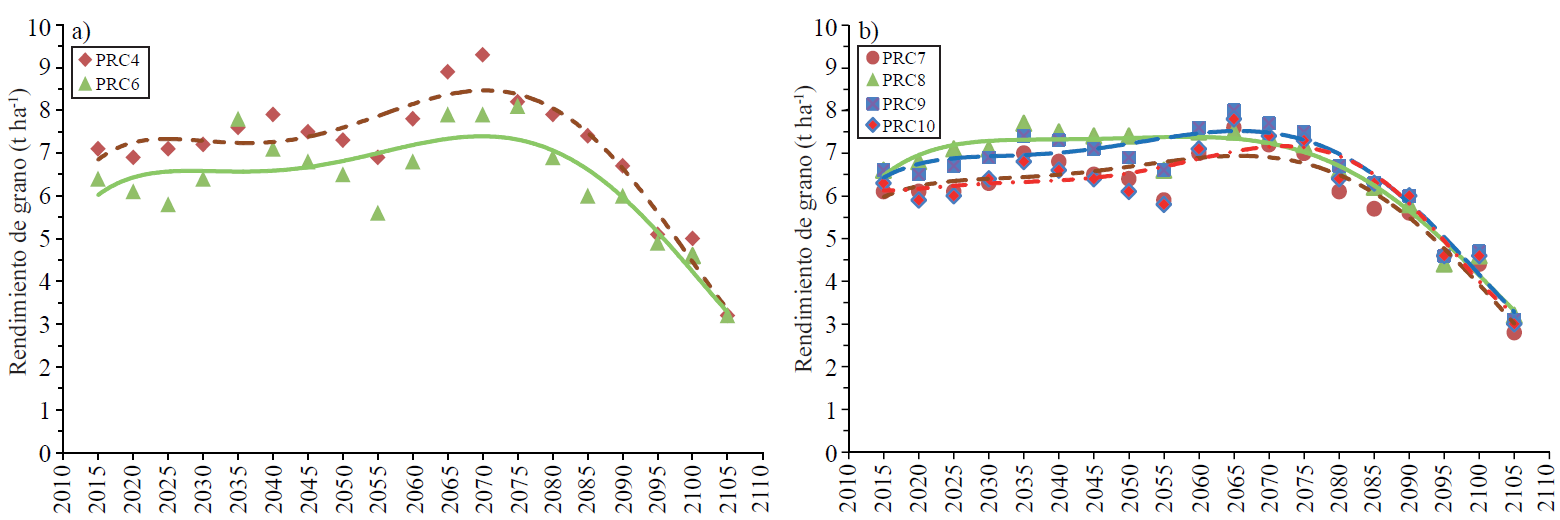
Figure 4 Trend of grain yield in rainfed maize: a) incorporation of crop residues; b) without crop residues, estimated every five years for the region Cienega of Jalisco in Mexico.
The highest content of OM in the soil has features that reduce the impact of climate change (Izaurralde et al., 2006), along with other benefits such as soil conservation, saving energy, time and labour, reduced machinery costs, moisture retention, reduced soil compaction (Figueroa et al., 1992). Part of the solution to the problem is a modification to the management practices of the PRC scenarios 7 to 10, as is the adaptation of technologies genotypes used shorter the cycle, incorporation of conservation tillage and planting density to generate IAF higher than 5, but it is also necessary to evaluate other factors that may reduce the effect of climate change, to identify practices that maintain stable yield subsequent to 2070.
Conclusions
The indices used for the calibration and validation of the model EPIC were used for estimating the yield ofmaize in the long term, in the Altos-Sur and Cienega regions of Jalisco. The modelling of maize yield in the region Altos-Sur of Jalisco, the PRC1 practice shows significant differences with respects to yield practices and PRC3 PRC2, but the practice PRC1 showed that after 2080, the yield tends to decline, a result attributed to the low density of plants expressed with IAF lower than 2.7; however, the PRC3 practice dampens the effects of climate change. For the region Cienega, no significant difference was shown in maize yield in the long term, but tend to decrease after 2075 yield.
Two contrasting groups of practices were present, where in one the crop residues are included in the soil, obtaining more organic matter, a condition that gives greater stability in maize yield until 2070, at which point it begins to decay the yield. Further research is needed to evaluate interactions with other management factors such as planting date, crop cycle, soil erosion dynamics of organic matter in the soil, which could dampen yield in the long term after 2070.
Literatura citada
Angulo, C.; Rótter, R.; Lock, R.; Enders, A.; Fronzek, S. and Ewert, F. 2013. Implication of crop model calibration strategies for assessing regional impacts of climate change in Europe. Agric. Forest Meteorol. 170:32-46. [ Links ]
Aurbacher, J.; Parker, S. P.; Calberto, S. G. A.; Steinbach, J.; Reinmuth, E.; Ingwersen, J. and Dabbert, S. 2013. Influence of climate change on short term management of field crops -a modelling approach. Agric. Systems. 119:44-57. [ Links ]
Causarano, H. J.; Shaw, J. N.; Franzluebbers, A. J.; Reeves, D. W.; Raper, R. L.; Balkcom, K. S.; Norfleet, M. L. and Izaurralde, R. C. 2007. Simulating field-scale soil organic carbon dynamics using EPIC. Soil Sci. Soc. Am. J. 71:1174-1185. [ Links ]
Chavas, D. R.; Izaurralde, R. C.; Thomson, A. M. and Gao, X. 2009. Long-term climate change impacts on agricultural productivity in eastern China. Agric. Forest Meteorol. 149:1118-1128. [ Links ]
De Witt, C. T. 1978. Simulation of assimilation, respiration, and transpiration of crops. Simulation Monographs. Centre for Agricultural Publishing and Documentation. Wageningen, Tha Netherlands. 432 p. [ Links ]
Farina, R.; Seddaiu, G.; Orsini, R.; Steglich, E.; Roggero, P. P. and Francaviglia, R. 2011. Soil carbon dynamics and crop productivity as influenced by climate change in a rainfed cereal system under contrasting tillage using EPIC. Soil Tillage Res. 112:36-46. [ Links ]
Ferrer, F.; Villar, J. M. and Stockle, C. O. 2000. Evaluación del modelo de simulación crop syst para maíz en el Valle del Ebro. Invest. Agr. Prod. Prot. Veg. 15(3):237-251. [ Links ]
Figueroa, S. B.; Amante, O. A.; Cortés, T. H. G.; Pimentel, L. J.; Osuna, C. E. S.; Rodríguez, O. J. M. y Morales, F. F. J. 1992. Manual de predicción de pérdidas de suelo por erosión. SARH-Colegio de Posgraduados. Salinas, S. L. P., México. 150 p. [ Links ]
Flores, H. E.; Olmos, J. J.; Ramírez, H.; Fuentes, V. O.; Reynoso, O. y Moreno, H. 2007. ET-59 Caracterización del sistema de producción de leche de la cuenca hidrográfica El Jihuite, Jalisco, México. Memorias del II Congreso Internacional de Producción Animal Tropical. 26 al 29 de noviembre. La Habana, Cuba. 21 p. [ Links ]
Flores, L. H. E.; Ireta, M. J.; Pérez, D. J. F.; Ruíz, C. J. A. y Díaz, M. P. 2009. Identificación de Buenas PrácticasAgrícolas para reducir la degradación del suelo e incrementar la calidad del agua: Metodología aplicada en la cuenca hidrográfica El Jihuite. Campo Experimental Centro Altos de Jalisco. Tepatitlán de Morelos, Jalisco, México. Libro científico Núm.1. 155 p. [ Links ]
Flores, L. H. E.; Paredes, M. R.; Ruvalcaba, G. J. M.; De La Mora, O. C. ; Pérez, D. J. F. e Ireta, M. J. 2011. Metodología para la evaluación del valor agregado del programa de maíz de alto rendimiento (PROEMAR) 2010 en Jalisco y Guanajuato. Campo Experimental Centro Altos de Jalisco. Tepatitlán de Morelos, Jalisco. México. Libro técnico Núm. 2. 162p. [ Links ]
Flores, L. H. E.; de La Mora Orozco, Á. C.; Chávez- Durán, A.; Ruiz Corral, J. A.; Ramírez- Vega H. and Fuentes- Hernández, V. O. 2012. Nonpoint pollution caused by the agriculture and livestock activities on surface water in the highlands of Jalisco, Mexico. In: resource management for sustainable agriculture Abrol, V. and Sharma, P. (Eds). InTech Publisher. Rijeka, Croatia. 85-112 pp. [ Links ]
Flores-López, H. E.; Hernández-Jáuregui, A. L.; Figueroa-Viramontes, U. y Castañeda- Villanueva A.A. 2012. Calidad microbiológica del agua por contaminación difusa de la aplicación de estiércoles en maíz y pasto. Tecnología y Ciencias delAgua. 3:127-141 pp. [ Links ]
Gaiser, T.; de Barros, I.; Sereke, F. and Lange, F. M. 2010. Validation and reliability of the EPIC model to simulate maize production in small-holder farming systems in tropical sub-humid WestAfrica and semi-arid Brazil. Agric. Ecosys. Environ. 135:318-327. [ Links ]
Gohari, A.; Eslamian, S.; Abedi-Koupaei, J.; Massah Bavani, A.; Wang, D. and Madani, K. 2013. Climate change impacts on crop production in Iran's Zayandeh-Rud River Basin. Sci Total Environ. 442:405-419. [ Links ]
Hatfield, J. L.; Boote, K. J.; Kimball, B. A.; Ziska, L. H.; Izaurralde, R. C.; Ort, D.; Thomson, A. M. and Wolfe, D. 2011. Climate impacts on agricultura: Implications for crop production. Agron. J. 103:351-370. [ Links ]
Hilger, T. H.; Herfort, J.; de Barros, I.; Gaiser, T.; Saboya, L. M. F.; Ferreira, L. G. R. andLeihner, D. E. 2000. Potential of EPIC/ALMANAC to Estímate CropYields under Erratic Rainfall in NE Brazil. German-Brazilian workshop on neotropical ecosystems - achievements and prospects ofcooperative research Hamburg- September 3-8, 2000 Session 7: Tools forIntegration of Ecosystem Studies towards the Development of Management Strategies. 49 p. [ Links ]
Hui, J. L. Er-da, T. Wheeler, A. Challinor, and Shuai, J. 2013. climate change modelling and its roles to chinese crops yield. J. Int. Agric. 12(5):892-902. [ Links ]
Hodges, T.; Botner, D.; Sakamoto, C. and Hays, H. J. 1987. Using the CERES-maize model to estimate production for the U.S. Corn Belt. Agric. For. Meteorol., 40:293-303. [ Links ]
Huszár, T.; Mika, J.; Lóczy, D.; Molnár, K and Kertész, Á. 2009. Climate Change and Soil Moisture: A Case Study. PHYS. Chem. Earth (A). 24(10):905-912. [ Links ]
Intergovernmental Panel on Climate Change (IPCC). 2007. Climate change 2007: mitigation of climate change. Contribution of working group III to the Fourth Assessment Report of the Intergovernmental Panel on Climate Change. In: Metz, B.; Davidson, O.; Bosch, P.; Dave, R. and Meyer, L. (Eds.). Cambridge University Press, UK. and USA. 851 p. [ Links ]
IPCC. 2013. Climate Change 2013: the physical science basis. Contribution of Working Group I to the Fifth Assessment Report of the Intergovernmental Panel on Climate Change [ Stocker, T. F.; Qin, D.; Plattner, G.-K.; Tignor, M.; Allen, S. K.; Boschung, J.; Nauels, A.; Xia, Y.; Bex, V. and Midgley, P. M. (Eds.)]. Cambridge University Press, Cambridge, United Kingdom and New York, NY, USA, 1535 p. [ Links ]
Izaurralde, R. C.; Thomson, A. M.; Morgan, J. A.; Fay, P. A.; Polley, H. W. and Hatfield, J. L. 2011.Climate impacts on agriculture: implications for forage and rangeland production. Agron. J. 103:371-381. [ Links ]
Izaurralde, R. C.; Williams, J. R.; McGill, W. B.; Rosenberg, N. J. and Quiroga, J. M. C. 2006. Simulating soil C dynamics with EPIC: Model description and testing against long-term data. Ecol. Modelling. 192:362-384. [ Links ]
Kiniry, J. R.; Major, D. J.; Izaurralde, R. C.; Williams, J. R.; Gassman, P. W.; Morrison, M.; Bergentine, R. and Zentner, R. P. 1995. EPIC model parameters for cereal, oilseed, and forage crops in the northern Great Plains region. Can. J. Plant Sci.75:679-688. [ Links ]
Lal, R.; Delgado, J. A.; Groffman, P. M.; Millar, N.; Dell, C. and Rotz, A. 2011. Management to mitigate and adapt to climate change. J. Soil Water Conser. 66(4):276-285. [ Links ]
Organización para las Naciones Unidas para la Agricultura y la Alimentación (FAO). 2007. Adaptation to climate change in agriculture, forestry and fisheries: perspective framework and priorities. FAO Interdepartmental Working Group on Climate Change. Rome, Italy. 24 p. [ Links ]
Ruiz, C. J. A.; Medina, G. G.; Ramírez, J. L. D.; Flores, L. H. E.; Ramírez, O. G.; Manríquez, O. J. D.; Zarazúa, V. P.; González, E. D. R.; Díaz, P. G. y de la Mora, O. C. 2011. Cambio climático y sus implicaciones en cinco zonas productoras de maíz en México. Rev. Mex. Cienc. Agríc. 2:309-323. [ Links ]
Villar-Sánchez, B.; López-Martínez, J.; Pérez-Nieto, J. y Camas-Gómez, R. 2003. Aplicación del modelo de simulación EPIC en la predicción del efecto de sistemas de labranza del suelo Terra Latinoamericana. 21(3):381-388. [ Links ]
Williams, J. R. 1990. The erosion-productivity impact calculator (EPIC) model: a case history. Philos. Trans. R. Soc. London 329:421-428. [ Links ]
Wang, X.; Harmel, R. D.; Williams, J. R. and Harman, W. L. 2006. Evaluation of EPIC for assessing crop yield, runoff, sediment and nutrient losses from watersheds with poultry litter fertilization. Transactions of the ASABE. 49:47-59. [ Links ]
Zarazúa, V. P. 2011. Evaluación del cambio climático y sus impactos sobre los cultivos de trigo, maíz y agave de la Región Ciénega de Chapala (análisis retrospectivo y análisis prospectivo). Tesis doctoral. Universidad de Guadalajara-CUCBA. Zapopan, Jalisco, México. 188 p. [ Links ]
Received: September 2014; Accepted: January 2015











 texto en
texto en 

